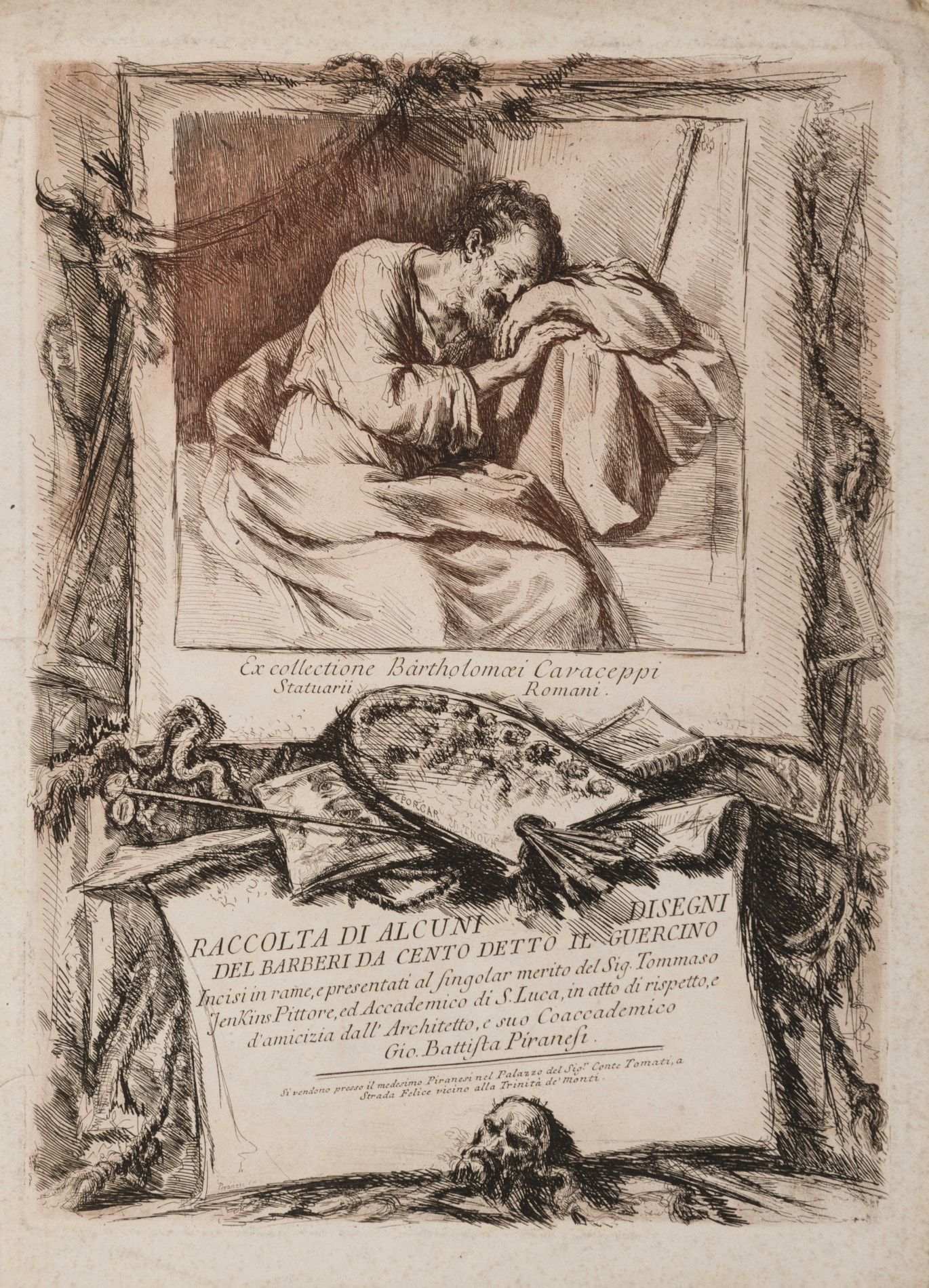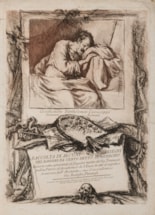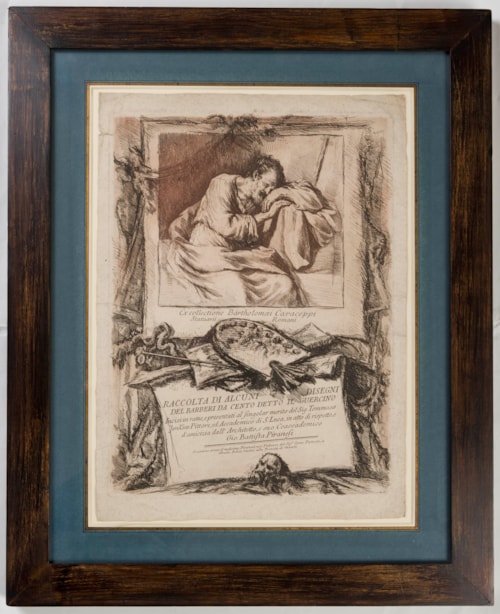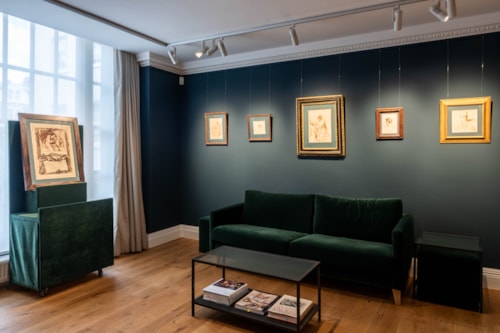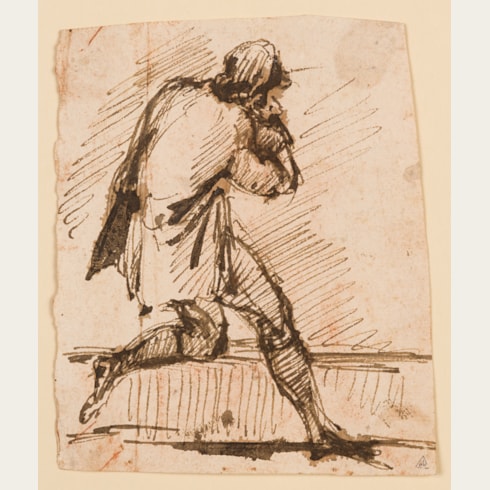Giovanni Battista PIRANESI
(Mogliano 1720 - Venice 1778)
Title Page for the Raccolta di Alcuni Disegni del Barberi da Cento detto Il Guercino
Sold
Etching on laid paper.
535 x 386 mm. (21 x 15 1/4 in.)
535 x 386 mm. (21 x 15 1/4 in.)
The inscription reads in full ‘RACCOLTA DI ALCUNI DISEGNI / DEL BARBERI [sic] DA CENTO DETTO IL GUERCINO / Incisi in rame, e presentati al singular merito del Sig. Tommaso / Jenkins Pittore, ed Accademico di S. Luca, in atto di rispetto, e / d’amicizia dall’ Architetto, e suo Coaccademico / Gio. Battista Piranesi.’ (‘Collection of several drawings after Barbieri da Cento known as Guercino, etched on copper, and presented to Thomas Jenkins, painter and member of the Academy of Saint Luke, out of respect and friendship from the architect, and his fellow academician Gio. Battista Piranesi.’)
This large print by Giambattista Piranesi served as the frontispiece to the Raccolta di Alcuni Disegni del Barberi [sic] da Cento detto Il Guercino; a series of twenty-eight etchings after drawings by the 17th century Giovanni Francesco Barbieri, known as Guercino (1591-1666) and a handful of other artists. The series was published by Piranesi in Rome in 1764, although he only etched this frontispiece and three of the plates; two after drawings by Guercino in his own collection and one after a drawing by Pier Leone Ghezzi. The remainder of the plates in the volume were etched by other printmakers, in particular Francesco Bartolozzi, who was responsible for the bulk of the etchings, as well as Aureliano Milani and Giovanni Ottaviani. Each of the twenty-one etchings after Guercino in the series noted the name of the owner or the location of the original drawing. While most of the drawings reproduced in the volume were in Venetian collections, a few were from the vast corpus of Guercino drawings that at the time were still held at the Casa Gennari, the home of the artist’s heirs in Bologna. These were the work of Bartolozzi, who seems to have sold the plates to Piranesi before his departure for England in 1764.
While the collecting of Old Master drawings was relatively common by the middle of the 18th century, the concept of publishing a group of them as prints in order to create a market for them was unusual, and it is interesting that it was the drawings of Guercino that were chosen for this project. As the Piranesi scholar John Wilton-Ely has further noted of these prints, and of the present etching in particular, ‘The group is particularly notable for Piranesi’s attempt to reproduce the pictorial quality of Guercino’s brush drawings by applying two colored inks, red and black, simultaneously to the copper plate. The title page to the collection, dedicated to Thomas Jenkins, the British dealer and a close collaborator of Piranesi’s who was elected to the Accademia di San Luca shortly before Piranesi himself, includes a reproduction of a Guercino drawing of St. Joseph belonging to another colleague, the restorer and dealer Bartolomeo Cavaceppi.’
Impressions of this etching are in a number of institutional collections, including the Rijksmuseum in Amsterdam, the Art Institute of Chicago, the National Galleries of Scotland in Edinburgh, the Hamburger Kunsthalle in Hamburg, the British Museum and the Victoria and Albert Museum in London, the J. Paul Getty Museum in Los Angeles, the Yale University Art Gallery in New Haven and the Metropolitan Museum of Art in New York.
This etching was until recently part of the collection of the noted British painter and printmaker Sir Howard Hodgkin (1932-2017).
This large print by Giambattista Piranesi served as the frontispiece to the Raccolta di Alcuni Disegni del Barberi [sic] da Cento detto Il Guercino; a series of twenty-eight etchings after drawings by the 17th century Giovanni Francesco Barbieri, known as Guercino (1591-1666) and a handful of other artists. The series was published by Piranesi in Rome in 1764, although he only etched this frontispiece and three of the plates; two after drawings by Guercino in his own collection and one after a drawing by Pier Leone Ghezzi. The remainder of the plates in the volume were etched by other printmakers, in particular Francesco Bartolozzi, who was responsible for the bulk of the etchings, as well as Aureliano Milani and Giovanni Ottaviani. Each of the twenty-one etchings after Guercino in the series noted the name of the owner or the location of the original drawing. While most of the drawings reproduced in the volume were in Venetian collections, a few were from the vast corpus of Guercino drawings that at the time were still held at the Casa Gennari, the home of the artist’s heirs in Bologna. These were the work of Bartolozzi, who seems to have sold the plates to Piranesi before his departure for England in 1764.
While the collecting of Old Master drawings was relatively common by the middle of the 18th century, the concept of publishing a group of them as prints in order to create a market for them was unusual, and it is interesting that it was the drawings of Guercino that were chosen for this project. As the Piranesi scholar John Wilton-Ely has further noted of these prints, and of the present etching in particular, ‘The group is particularly notable for Piranesi’s attempt to reproduce the pictorial quality of Guercino’s brush drawings by applying two colored inks, red and black, simultaneously to the copper plate. The title page to the collection, dedicated to Thomas Jenkins, the British dealer and a close collaborator of Piranesi’s who was elected to the Accademia di San Luca shortly before Piranesi himself, includes a reproduction of a Guercino drawing of St. Joseph belonging to another colleague, the restorer and dealer Bartolomeo Cavaceppi.’
Impressions of this etching are in a number of institutional collections, including the Rijksmuseum in Amsterdam, the Art Institute of Chicago, the National Galleries of Scotland in Edinburgh, the Hamburger Kunsthalle in Hamburg, the British Museum and the Victoria and Albert Museum in London, the J. Paul Getty Museum in Los Angeles, the Yale University Art Gallery in New Haven and the Metropolitan Museum of Art in New York.
This etching was until recently part of the collection of the noted British painter and printmaker Sir Howard Hodgkin (1932-2017).
From his first visit to Rome in 1740, Giambattista Piranesi was interested in architecture and stage design, which he had studied in the studio of Domenico and Giuseppe Valeriani. By 1743 he had settled in Rome, and that year published etchings of several of his architectural designs as the Prima parte de architetture e prospettive, in which he adapted antique Roman forms into a modern, more unrestrained idiom, partly inspired by his early interest in stage design. Piranesi’s most celebrated works, the Le carceri (1743-1746) and Le antichita romane (1756) came soon afterwards. With the accession of the Venetian Carlo Rezzonico to the papacy as Pope Clement XIII in 1758, Piranesi was at last able to put some of his architectural theories to practice. The papal court provided important commissions to Venetian artists, chief among them Piranesi. In 1764 he was commissioned by the Pope’s nephew, Cardinal Giovanni Battista Rezzonico, to oversee the restoration of the church of Santa Maria del Priorato on the Aventine hill, and at around the same time was asked to draw up plans for the rebuilding of the west end of the Basilica of San Giovanni Laterano. His last years were spent making drawings of the antiquities discovered at Pompeii and Herculaneum, some of which were later engraved by his son Francesco.
Provenance
Howard Hodgkin, London.
Literature
Henri Focillon, Giovanni-Battista Piranesi: Essai de catalogue raisonné de son œuvre, Paris, 1918, p.66, no.983; Alberto Alberghini, Guercino: Le Collezione di Stampe, Cento, 1991, p.215, fig.430;John Wilton-Ely, Giovanni Battista Piranesi: The Complete Etchings, Vol. II, San Francisco, 1994, pp.1108-1109, no.1015.

